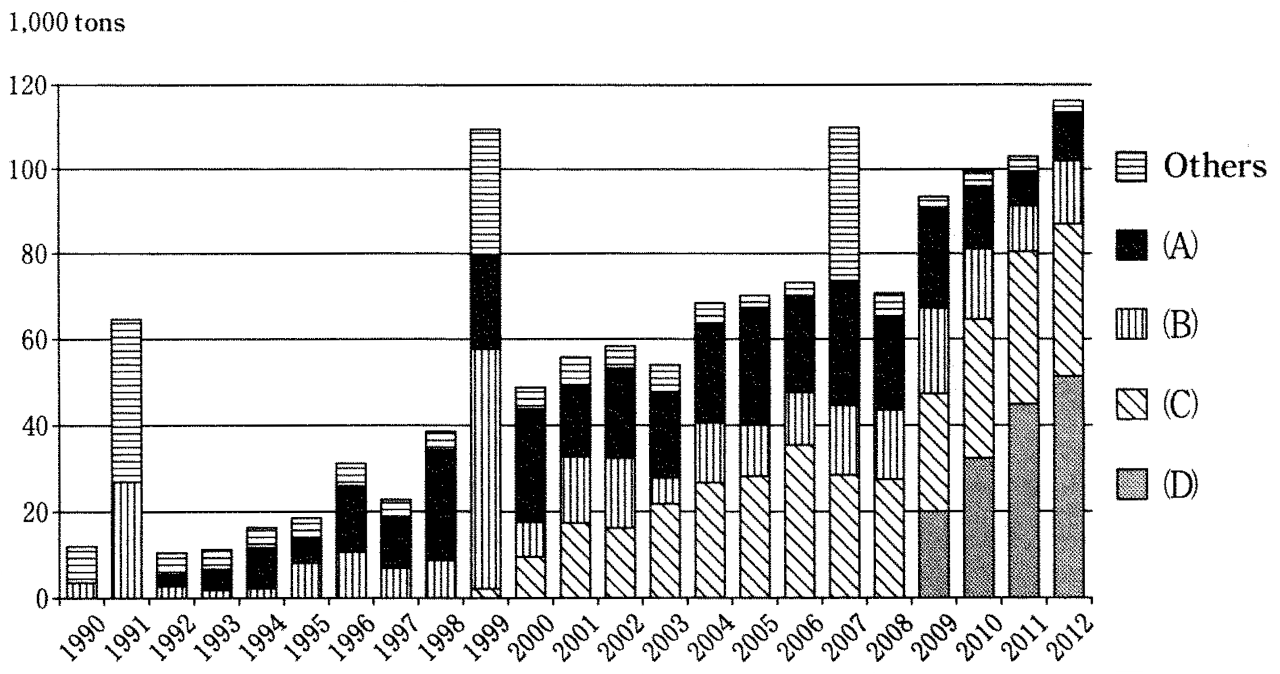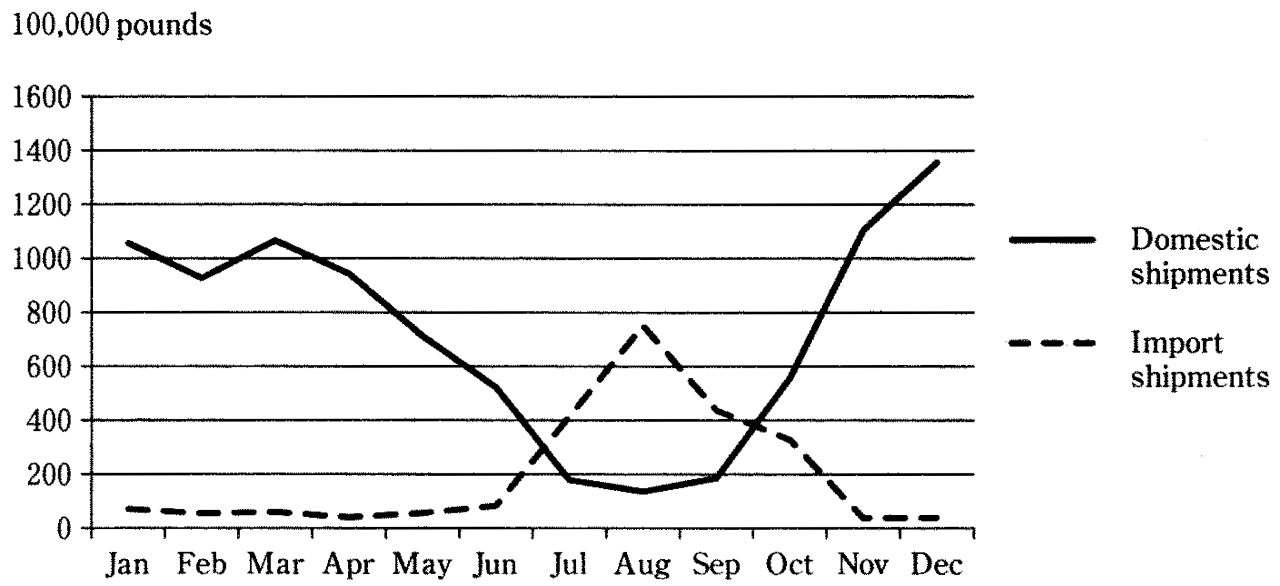【センター試験過去問】英語(筆記)2016本試【本文と和訳・正解】
第4問A
次の文章はある説明文の一部である。この文章とグラフを読み、下の問い(問1~4)の35~38に入れるのに最も適当なものを、それぞれ下の①~④のうちから一つずつ選べ。
US consumers have benefited from an increased volume and variety of fresh-fruit imports, particularly since the 1990s. The fruit and vegetable section in today’s grocery store often has dozens of different fresh fruits on display all year around, which come from all corners of the globe as additions to domestic fresh fruit.
The rapid growth of fresh-fruit imports has affected many aspects of the US fresh-fruit market. For example, while oranges are the US’s leading domestically grown fruit, the volume of US orange imports has grown steadily since the 1990s, with occasional sudden increases when the US crop experienced freezing weather (see Figure 1).

Figure 1. US fresh-orange imports by country.
The US domestic market receives orange imports from various countries and regions. Among the major suppliers, Mexico is a longtime source. However, due to the strong US demand for fresh oranges throughout the year, the Southern Hemisphere countries have also become major suppliers, especially during the summer months when domestic navel oranges are not available. Australia was the first such country, starting in the early 1990s after it obtained permission from the US government to export its navel oranges there. Australia was followed by South Africa in the late 1990s, and most recently by Chile as well.
In the US, two main types of oranges are produced domestically: “navel oranges” and “Valencia oranges.” Navel oranges ― virtually without seeds, with flesh that separates easily and is firm rather than watery ― are the most popular oranges for eating fresh. The navel orange share of US production of fresh-market oranges was 76 percent during the years 2010-2012. In comparison, Valencia oranges ― with thin skins, containing occasional seeds, and with juicy and sweet flesh ― accounted for 24 percent during the same period. As the US’s top supplier of fresh-market oranges, California produced 87 percent of fresh-market navel oranges and more than 81 percent of fresh-market Valencia oranges.
The main harvest period for domestic fresh-market oranges is from November through May, a time when California’s navel oranges are in season. However, the amount of oranges produced and shipped domestically falls significantly from June through October. In earlier years, when fresh-orange imports still accounted for only a small portion of domestic use, Valencia oranges were a popular variety when navel oranges were out of season. As seen in Figure 2, however, navel orange imports from the Southern Hemisphere countries have come to dominate the US in the summer season.

Figure 2. Seasonal relationship between imported and domestic oranges (2010-2012 average).
Because of seasonal production patterns, the majority of Mexico’s oranges arrive in the US market from December through June, when US supplies are relatively high. In contrast, the season for imports from the Southern Hemisphere countries is mainly from July through October, when US supplies are relatively low. This trend is similar to that seen with many other fruits as well.
(Sophia Wu Huang (2013) Imports Contribute to Year-Round Fresh Fruit Availability を参考に作成)
問1 In Figure 1, which of the following do (A), (B), (C), and (D) refer to? 35
① (A)Australia (B)Chile (C)Mexico (D)South Africa
② (A)Australia (B)Mexico (C)South Africa (D)Chile
③ (A)South Africa (B)Chile (C)Australia (D)Mexico
④ (A)South Africa (B)Mexico (C)Australia (D)Chile
問2 According to the passage, which of the following correctly describes one difference between navel oranges and Valencia oranges? 36
① Navel oranges contain fewer seeds than Valencia oranges do.
② Navel oranges contain more juice than Valencia oranges do.
③ Valencia oranges are more popular than navel oranges in the winter.
④ Valencia oranges are more suitable for eating fresh than navel oranges.
問3 What is the main purpose of this passage? 37
① To account for the seasonal changes in the US production of oranges
② To explain the differences between navel oranges and Valencia oranges
③ To illustrate the relation between US production and imports of oranges
④ To improve the quality of the navel oranges produced in the US
問4 What topic is most likely to follow the last paragraph? 38
① Export rates of other fruits from the US to the Southern Hemisphere
② Statistics showing the seasonal changes in imports of other fruits
③ The shipping methods of navel oranges from the Southern Hemisphere
④ The variety of fruits commonly grown in the US and Mexico
正解と和訳
アメリカの消費者は、特に1990年代以降、生鮮果物の輸入の量と種類の増加から恩恵を受けてきた。今日の食料品店の果物と野菜のコーナーには、一年中陳列されているさまざまな新鮮な果物がたくさんある。
生鮮果物の輸入の急成長は、アメリカの生鮮果物の市場の多くの側面に影響を与えてきた。たとえば、オレンジはアメリカの主要な国産果物であるが、1990年代以降、アメリカのオレンジ輸入量は着実に増加しており、アメリカの作物が寒冷な天候を経験するとき、急激に増加することがある(図1参照)。
図1 国ごとのアメリカの生鮮オレンジの輸入
アメリカの国内市場は、さまざまな国や地域からオレンジの輸入品を受け入れている。主な供給国の中で、メキシコが古くからの供給国である。しかし、年間を通した生鮮オレンジに対するアメリカの強い需要のために、南半球諸国も、特に国内のネーブルオレンジが入手できない夏の間に、主要な供給国となってきている。オーストラリアはそのような最初の国で、アメリカ政府からネーブルオレンジを輸出する許可を得た後、1990年代初頭に始まった。オーストラリアに、1990年代後半に南アフリカが続き、もっとも最近ではチリも続いている。
アメリカでは、主に2種類のオレンジが国内で生産されている。「ネーブルオレンジ」と「バレンシアオレンジ」である。ネーブルオレンジは事実上種がなく、容易に分離する果肉を持ち、水っぽくなく引き締まっていて、新鮮な状態で食べるための最も人気のあるオレンジである。2010年から2012年の間のアメリカの生鮮市場用オレンジ生産におけるネーブルオレンジの割合は2010~2012年で76%であった。比較すると、薄い皮を持ち、ときどき種子を含み、ジューシーで甘い果肉を持つバレンシアオレンジは、同時期に24パーセントを占めた。生鮮市場向けオレンジのアメリカの最大の供給者として、カリフォルニアは生鮮市場向けネーブルオレンジの87%、生鮮市場向けバレンシアオレンジの81%以上を生産した。
国内の生鮮市場向けオレンジの主な収穫期は11月から5月で、カリフォルニアのネーブルオレンジがシーズンの時である。しかし、国内で生産および出荷されているオレンジの量は、6月から10月にかけて大幅に減少する。初期には、生鮮オレンジの輸入がまだ国内利用のほんの一部しか占めていなかったとき、ネーブルオレンジがシーズン外のとき、バレンシアオレンジが人気のある品種であった。しかし、図2に見られるように、南半球諸国からのネーブルオレンジの輸入が夏季にアメリカを支配するようになった。
図2.輸入オレンジと国産オレンジの間の季節的関係(2010-2012年平均)。
季節的な生産パターンのため、メキシコのオレンジの大部分は、アメリカの供給量が比較的多い12月から6月にかけてアメリカ市場に到着する。対照的に、南半球諸国からの輸入の季節は主に7月から10月であり、そのときアメリカの供給量は比較的少ない。この傾向は、他の多くの果物でも見られる傾向と似ている。
問1 35 正解 ②
図1では、(A)、(B)、(C)、(D)は以下のうちどれのことか。 35
① (A)オーストラリア (B)チリ (C)メキシコ (D)南アフリカ
② (A)オーストラリア (B)メキシコ (C)南アフリカ (D)チリ
③ (A)南アフリカ (B)チリ (C)オーストラリア (D)メキシコ
④ (A)南アフリカ (B)メキシコ (C)オーストラリア (D)チリ
問2 36 正解 ①
文章によると、次のうちどれがネーブルオレンジとバレンシアオレンジの一つの違いを正しく説明しているか。
① ネーブルオレンジはバレンシアオレンジよりも種子が少ない。
② ネーブルオレンジはバレンシアオレンジよりも果汁が多い。
③ 冬には、バレンシアオレンジはネーブルオレンジよりも人気がある。
④ バレンシアオレンジは、ネーブルオレンジよりも新鮮な状態で食べるのに適している。
問3 37 正解 ③
この文章の主な目的は何か。
① アメリカ産オレンジの季節ごとの変化を説明すること
② ネーブルオレンジとバレンシアオレンジの違いを説明すること
③ アメリカのオレンジの生産と輸入の関係を説明する
④ アメリカ産ネーブルオレンジの品質を向上すること
問4 38 正解 ②
最後の段落に続く可能性が最も高い話題は何か。
① アメリカから南半球への他の果物の輸出率
② 他の果物の輸入の季節ごとの変化を示す統計
③ 南半球からのネーブルオレンジの出荷方法
④ アメリカとメキシコで一般的に栽培されている果物の種類
第4問B
次のページの美術館に関するウェブサイトを読み、次の問い(問1~3)の39~41に入れるのに最も適当なものを、それぞれ下の①~④のうちから一つずつ選べ。
問1 Kazuko, a 19-year-old shop assistant, wants to participate in a museum activity but is only free on weekday evenings. Which activity will she most likely choose? 39
① Comprehensive tour
② Drawing class
③ Photography workshop
④ Short tour
問2 A retired couple and their 6-year-old grandchild wish to participate together in a weekday afternoon activity. Which activity will they most likely choose and how much will they pay in total? 40
① Comprehensive tour, $20
② Comprehensive tour, $40
③ Short tour, $20
④ Short tour, $28
問3 Which of the following is true according to the website? 41
① Advance booking is not necessary for “Art Talks.”
② Comprehensive tours are held every day.
③ The admission fee is not included in the fees of tours.
④ There are lectures given by amateur artists.
Octagon Museum of Art
Octagon Museum of Art (OMA) offers exhibitions and programs featuring contemporary art such as paintings, sculptures, and photographs. Established in 1972 by the Octagon Foundation, it has a vast collection with many permanent exhibits, and also offers special exhibits, lectures by professional artists and critics, classes for school children, and tours guided by specialists.
Admission Fee: $5/person (Children 6 and under ― free)
Program Fees:
| Short tour (90 minutes) |
Adult (18+) | $10 | Twice daily 9 am & 2 pm |
| Student (7-17) | $8 | ||
| Child (6 and under) | free | ||
| Comprehensive tour (3 hours) |
Adult (18+) | $20 | Tuesday & Saturday 10 pm |
| Student (7-17) | $15 | ||
| Child (6 and under) | free | ||
| Drawing class (90 minutes) |
Adult (18+) | $15 | Monday, 7 pm |
| Student (7-17) | $8 | Wednesday, 4 pm | |
| Child (6 and under) | free | Wednesday, 10 pm | |
| Photography workshop (2 hours) |
Adult (18+) | $17 | Sunday, 7 pm |
| Student (7-17) | $12 | Sunday, 10 pm |
Notes:
– The fees for tours, classes, and workshops include the admission fee.
– Sign up here at least a week in advance for tours, classes, and workshops.
– We also offer “Art Talks,” where invited guest speakers talk to adult audiences in OMA Hall every other Saturday. No reservation or additional fee is required. For this month’s schedule, click here.
正解と和訳
問1 39 正解 ②
19歳の店員であるカズコは、美術館での活動に参加したいが、平日の夜のみ暇である。彼女はどの活動を選ぶ可能性が最も高いか。
① 総合ツアー
② 絵画クラス
③ 写真ワークショップ
④ 短時間ツアー
問2 40 正解 ③
引退した夫婦と6歳の孫が平日の午後の活動に一緒に参加したいと考えている。彼らはどの活動を選択する可能性が最も高く、合計でいくら支払うか。
① 総合ツアー、20ドル
② 総合ツアー、40ドル
③ 短時間ツアー、20ドル
④ 短時間ツアー、28ドル
問3 41 正解 ①
ウェブサイトによると、次のうちどれが正しいか。
① 「芸術トーク」に事前予約は必要ない。
② 総合ツアーは毎日開催されている。
③ 入場料はツアーの料金に含まれていない。
④ アマチュア芸術家による講演がある。
オクタゴン美術館
オクタゴン美術館(OMA)では、絵画、彫刻、写真などの現代美術を特色にした展示会やプログラムを開催しています。オクタゴン財団によって1972年に設立され、それは多くの常設展示を含む膨大な収蔵品を持ち、また特別展示、プロの芸術家や評論家による講義、学校の子供たちのための授業、そして専門家によるガイド付きツアーを提供しています。
入場料:5ドル/一人(6歳以下 ― 無料)
プログラム料金:
| 短時間ツアー (90分) |
大人(18歳以上) | 10ドル | 毎日2回 午前9時と午後2時 |
| 学生(7~17歳) | 8ドル | ||
| 子供(6歳以下) | 無料 | ||
| 総合ツアー (3時間) |
大人(18歳以上) | 20ドル | 火曜日と土曜日 午前10時 |
| 学生(7~17歳) | 15ドル | ||
| 子供(6歳以下) | 無料 | ||
| 絵画クラス (90分) |
大人(18歳以上) | 15ドル | 月曜 午後7時 |
| 学生(7~17歳) | 8ドル | 水曜日 午後4時 | |
| 子供(6歳以下) | 無料 | 水曜日 午後4時 | |
| 写真ワークショップ (2時間) |
大人(18歳以上) | 17ドル | 日曜日 午後7時 |
| 学生(7~17歳) | 12ドル | 日曜日 午前10時 |
注意:
-ツアー、授業、ワークショップの料金には入場料が含まれています。
-ツアー、授業、ワークショップは、少なくとも1週間前にここで登録してください。
-招待講演者が隔週土曜日にOMAホールで大人の観客と話す「芸術トーク」も開催しています。予約や追加料金は必要ありません。今月のスケジュールはここをクリックしてください。
SNSでシェア